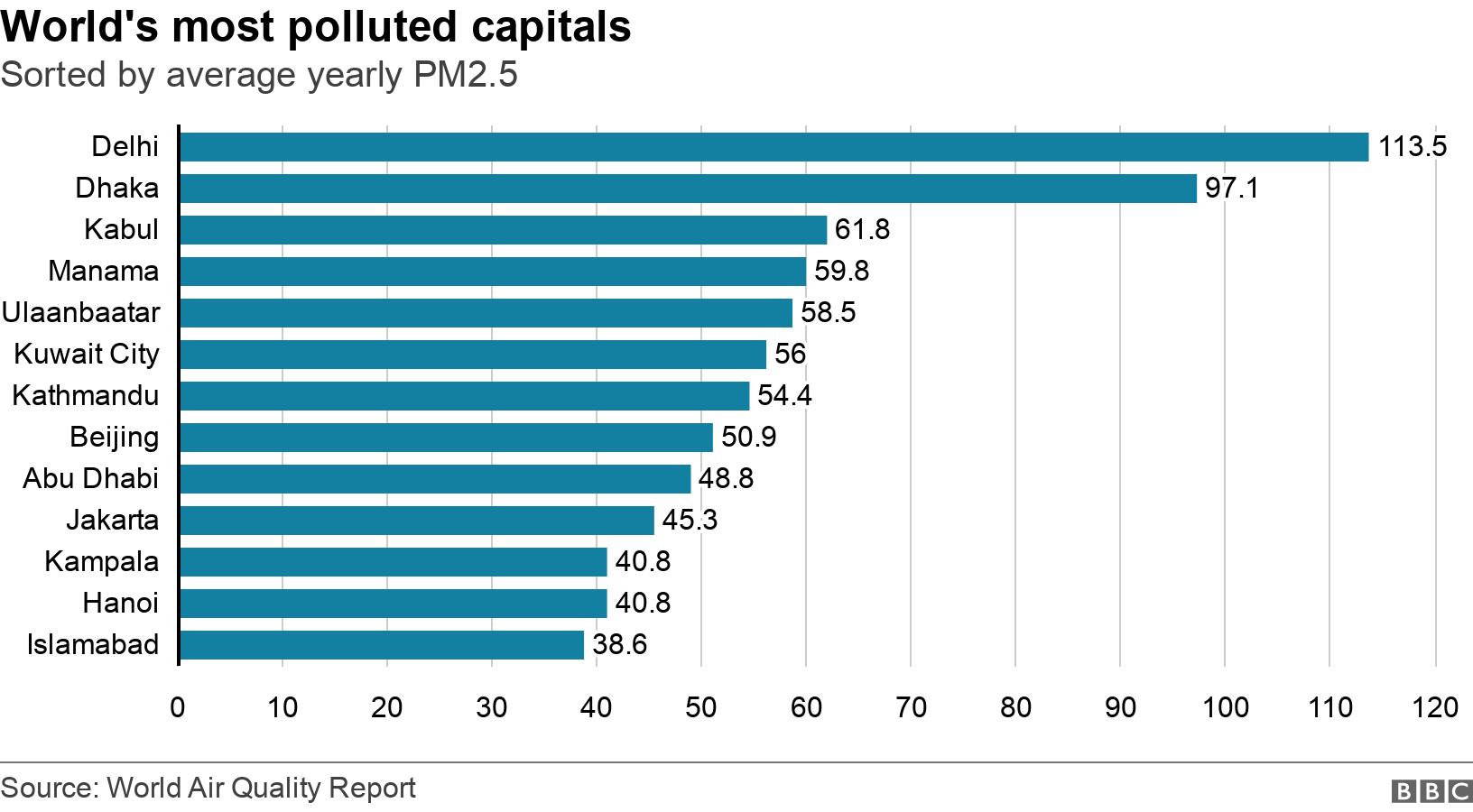Asia: The Epicenter of Air Pollution
According to a recent report by IQAir, all but one of the 100 cities with the worst air pollution in the world last year were located in Asia. This alarming statistic highlights the critical role the climate crisis plays in deteriorating air quality, posing a significant risk to the health of billions of people globally. Out of these cities, a staggering 83 were in India, surpassing the World Health Organization's air quality guidelines by more than 10 times. The study focused specifically on fine particulate matter, known as PM2.5, which is the smallest and most dangerous pollutant. Shockingly, only 9% of the 7,800 cities analyzed worldwide met the WHO's standard, which states that average annual levels of PM2.5 should not exceed 5 micrograms per cubic meter.
The impact of air pollution on human lives is evident. IQAir Global CEO Frank Hammes explains that air pollution, particularly in severely affected countries, can significantly reduce people's lifespan by three to six years, leading to years of preventable suffering. PM2.5, when inhaled, can penetrate deep into the lungs and even enter the bloodstream. It stems from various sources such as the combustion of fossil fuels, dust storms, and wildfires. The consequences of exposure to PM2.5 include respiratory illnesses, heart and lung diseases, asthma, cancer, cognitive impairment in children, and other severe health issues.
The city of Begusarai in northern India's Bihar state topped the list as the most polluted city in the world last year, with an average annual PM2.5 concentration of 118.9, exceeding the WHO guidelines by 23 times. Following closely behind were Guwahati, Assam; Delhi; and Mullanpur, Punjab, all in India. The report reveals that a staggering 96% of India's population, totaling 1.3 billion people, live with air quality seven times higher than the WHO guidelines. Central and South Asia emerged as the worst-performing regions globally, with Bangladesh, Pakistan, India, and Tajikistan being the four most polluted countries. South Asia is of particular concern, as 29 out of the 30 most polluted cities are located in India, Pakistan, or Bangladesh. Major population centers such as Lahore (5th), New Delhi (6th), and Dhaka (24th) ranked prominently in the report.
Addressing the air pollution crisis in these regions requires significant changes in energy infrastructure and agricultural practices, according to Hammes. It is also crucial to acknowledge that the factors causing outdoor air pollution often contribute to indoor air pollution as well. For instance, cooking with dirty fuel indoors can result in exposure that exceeds outdoor pollution levels.
A Global Challenge
The IQAir report reveals that 92.5% of the 7,812 locations analyzed across 134 countries, regions, and territories exceeded the WHO's PM2.5 guidelines. Only ten countries and territories, including Finland, Estonia, Puerto Rico, Australia, New Zealand, Bermuda, Grenada, Iceland, Mauritius, and French Polynesia, were found to have "healthy" air quality. Shockingly, millions of people die each year due to air pollution-related health issues. A study published in the BMJ in November found that air pollution from fossil fuels alone is responsible for the deaths of 5.1 million people annually, while the combined effects of ambient and household air pollution lead to 6.7 million deaths per year, as reported by the WHO.
The IQAir report emphasizes that the human-caused climate crisis, primarily driven by the burning of fossil fuels, plays a pivotal role in exacerbating air pollution levels. Climate change alters weather patterns, affecting wind and rainfall patterns, which, in turn, impacts the dispersion of pollutants. As the climate crisis intensifies, pollution is expected to worsen, with extreme heat becoming more frequent and severe. Moreover, climate change contributes to more severe wildfires and longer, more intense pollen seasons, both of which further compound the health risks associated with air pollution.
The interconnectedness of the climate crisis and air pollution underscores the importance of addressing both issues simultaneously. Reducing air pollution not only has a positive impact on public health but also contributes to mitigating climate gas emissions. Efforts to combat air pollution and the climate crisis go hand in hand and require collective action from governments, communities, NGOs, companies, and scientists.
Regional Rankings: North America and Asia
In North America, wildfires that ravaged Canada from May to October 2023 had a significant impact on air pollution levels. The report found that the monthly average of air pollution in Alberta in May was nine times higher than the same month in 2022. For the first time, Canada surpassed the United States in the regional pollution rankings. Cities such as Minneapolis and Detroit experienced a 30% to 50% increase in annual pollution averages compared to the previous year due to the wildfires. Columbus, Ohio, retained its title as the most polluted major US city for the second consecutive year. However, major cities like Portland, Seattle, and Los Angeles saw significant drops in annual average pollution levels.
In contrast, pollution levels rebounded across much of Asia. China, which had made progress in reducing pollution levels over the past five years, experienced a reversal in this trend. The average Chinese citizen's lifespan had increased by 2.2 years due to clean air policies. However, Beijing saw a 14% increase in the annual average PM2.5 concentration, leading to a return of thick smog. Hotan, China's most polluted city, ranked 14th in the IQAir ranking. In Southeast Asia, only the Philippines witnessed a drop in annual pollution levels compared to the previous year. Indonesia had the highest pollution increase in the region, followed by Vietnam and Thailand. Cities in these countries exceeded WHO PM2.5 guidelines by more than 10 times, leading to governmental interventions like work-from-home orders and concerns over tourism in highly polluted areas.
Inequality and Encouraging Developments
The report highlights a concerning inequality when it comes to air quality data availability. Countries in Africa, South America, and the Middle East suffer from a lack of monitoring stations, resulting in limited air quality data in these regions. Although Africa saw an improvement in the number of countries included in this year's report compared to previous years, it remains the most underrepresented continent. Only 24 out of 54 African countries had sufficient data available from their monitoring stations. The 2023 rankings included seven African countries that were not considered in previous years, such as Burkina Faso (the fifth most polluted country) and Rwanda (ranked 15th). However, several countries that ranked high on the most polluted list in 2022 were excluded from the 2023 report due to a lack of available data, including Chad, which held the title of most polluted country.
Despite these challenges, one positive development is the increasing pressure and civic engagement from communities, NGOs, companies, and scientists to monitor air quality. This growing awareness and activism demonstrate to governments that people care about the issue and are demanding action.
It is clear that air pollution is a global problem with severe implications for public health and the environment. Tackling this crisis requires concerted efforts to reduce emissions, transition to cleaner energy sources, improve agricultural practices, and address the underlying causes of the climate crisis. By prioritizing air quality and sustainable measures, we can create a healthier future for all.

